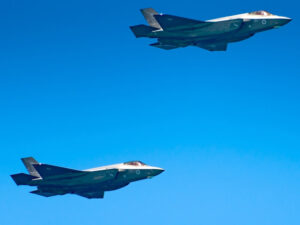The third Chinese carrier Fujian recently went to sea for trials, at some times trailing an Admiral Kuznetsov-like plume of smoke, reminiscent of the troubled Russian carrier’s last voyage outside home waters in 2023 when its engineering troubles made for global headlines.
China has been in pursuit of a carrier aviation capability for nearly 40 years, using every imaginable method to acquire carriers via deception, amusement park attraction and finally domestic carrier production.
So far, Chinese carriers have not embarked on extended global deployments in support of Chinese overseas policy and interest. They have instead formed a “fleet in being” in the Chinese “near abroad,” within the “first island chain”, the maritime space bounded by the East Asia continental mass and the first groups of archipelagic states including the western boundary of the Philippines and Taiwan and stretching from Maylasia north to the Kamchatka peninsula.
Chinese carrier operations have been limited by U.S. standards with Chinese flattops seldom achieving more than 60 sorties per day, as compared to the U.S. Nimitz-class that routinely achieves 120 daily sorties and the new Ford class that has reached 160 sorties in exercise events. The Chinese quest for carrier aviation is starting to show some success, but it remains a nascent capability in comparison to that of the United States, Great Britain and France, whose carriers deployed throughout the world during the Cold War.
China’s carrier quest
During the Cold War U.S., the presidential watchword “where are the carriers” and the success the U.S. achieved with carrier-based airpower in war and peace likely convinced the People’s Republic of China (PRC) that it also needed a force of flattops.
China had been interested in carrier aviation since 1985 when the Chinese government acquired the decommissioned Australian carrier HMAS Melbourne for scrapping in China. The Chinese military studied the ship for years and reportedly removed the ship’s flight deck and one of its catapults for land-based testing.
Following the Cold War’s end, the Chinese also acquired the former Soviet vertical take-off and landing (VSTOL) carriers Minsk in 1995 and Kiev in 2000, ostensibly as a theme park centerpiece and a floating luxury hotel. These ships may have provided further study materials for the People’s Liberation Army Navy. China also tried to purchase the decommissioned French carrier Clemenceau in 1997, but the ship was instead scrapped.
China’s ambitions of a fully functioning carrier improved with the 1998 purchase of the ex-Soviet carrier Varyag, a ship of the same class as the Russian carrier Kuznetsov, but left in the custody of Ukraine upon the collapse of the Soviet Union in 1991 and only 68% complete. The Chinese government used what appeared to be a fake company name to purchase the ship, and again Chinese officials claimed the incomplete ship would become a floating hotel.
The Chinese project team that worked to make the carrier functional declared that it took the work of building ten destroyers to make the new carrier, now named Liaoning, ready for sea trials. The completion of this first carrier set the stage for the construction of follow-on vessels of similar design in Chinese shipyards.
China’s carriers versus their Western counterparts
Propulsion methods can influence the number of days deployed, but probably not yet in terms of Chinese carriers. U.S. flattops and the French carrier Charles De Gaulle have nuclear propulsion that gives them unlimited mobility for years. The British Queen Elizabeth class carriers do not have nuclear power, but that has not prevented their operations on a global scale. The next Chinese carrier could be nuclear, and that could aid in its global employment, but current British and past American global conventional carrier operations were not impeded by a lack of nuclear power.
So far the Chinese carrier fleet has been conventionally powered to include the latest vessel Fujian. Following Liaoning, the Chinese built a near-sister ship commissioned in 2022 and named it the Shandong. This vessel was very similar to the Liaoning, as the Chinese had purchased the blueprints of the ex-Varyag in addition to the ship itself in 1998.
Commissioned in December 2019, the Shandong operated in the Philippine Sea for 19 days, several in the immediate vicinity of Taiwan in December 2023. U.S. reports suggest Shandong achieved roughly 60 sorties per day over this operating period, with one-third of those helicopters.
While better than the 22 per day registered by Liaoning in a 15-day operating period in December 2022, these figures are nowhere near those of the U.S., French, and British carrier forces.
Nimitz class carriers flew 120-130 sorties per day during the first part of the 2003 war in Iraq. The French carrier Charles De Gaulle is credited with being able to fly 100 sorties per day.. During operations against the ISIS terror group in 2015, the ship flew an average of 10 to 15 combat sorties per day with a single, reinforced strike fighter squadron embarked over a two-month period.
The British Queen Elizabeth-class carriers are credited with being able to mount 72 jet aircraft sorties per day. On the lead ship’s initial deployment with two F-35B squadrons it “completed more than 1,278 sorties, flew more than 2,200 hours, and conducted 44 combat missions in support of the counter-ISIS mission — Operation Inherent Resolve,” over a seven-month period. The Indian navy has also operated carriers for over 50 years, and it too is building more carriers, although its sortie rates remain relatively unknown.
The most important aspect however of carrier operations is the ability to persist and sustain operations over prolonged periods. U.S. and allied carriers have flown consistent combat flight operations for weeks at time. The world has not seen a potential carrier faceoff since the 1982 Falklands War, when the Argentine carrier Veinticinco de Mayo was unable to launch an airstrike against the British carriers HMS Hermes and HMS Invincible due to light winds over the deck and faltering engines.
While not fighting peer opponents, U.S. and allied carriers have years of experience flying combat missions in Iraq, Afghanistan and the wider Levant that Chinese aviators cannot match. The bulk of the Chinese navy including its carriers seems committed for now to a “fleet in being” concept with operations inside, but rarely if ever passing the first island chain barrier, let alone the kind of global deployments executed regularly by U.S and Allied carriers. Twenty-day training periods are not real deployments.
What it means for the U.S. and allies
China has purchased and now built and operated carriers to a competent, albeit limited standard of success as compared with the U.S. and other Western state carriers.
China’s flattops seem part of a larger, regional fleet concept, not unlike that of the pre-World War I German High Seas Fleet that was concentrated in the North Sea as a deterrent to a British attack or close blockade of the limited German coast.
Such a formation is dangerous to the U.S. and its allies in the region as the Chinese can entirely concentrate their naval power where the U.S. would likely need to abandon other oceans and rebalance more fully to the Western Pacific. On the other hand, a Chinese fleet that remains close to home cannot defend China’s growing global interests that include ports, raw material sources and the sea lines of communication that allow their safe transport to China.
It will be interesting to observe how China deals with these conflicting obligations with its fleet as it presumably builds more carriers with some sources suggesting a goal of six such ships. That said, China will have to keep marching to catch up to the U.S. and allied nations in terms of operations at sea.







